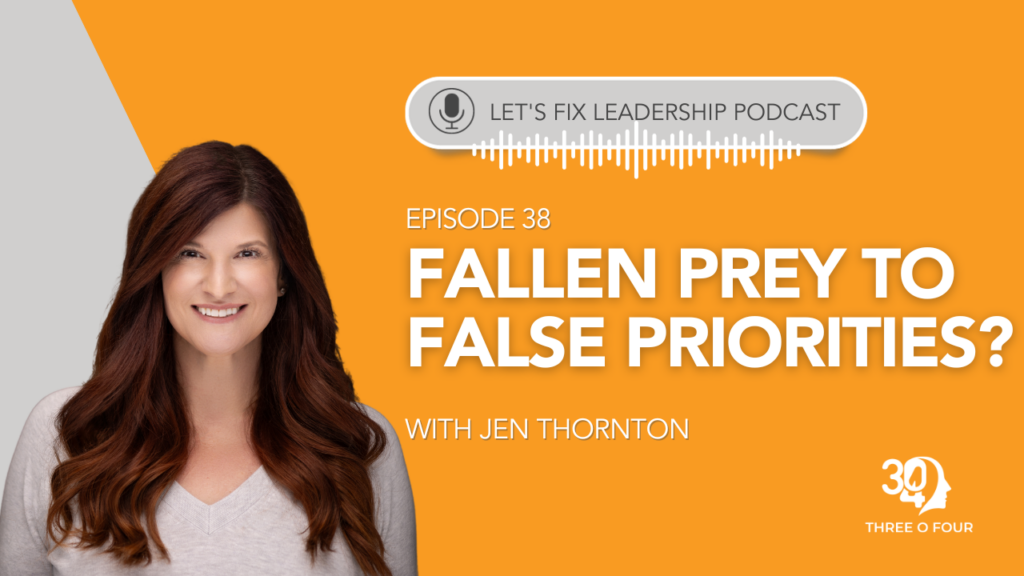Following a rigid hiring rule over filling a position with a great candidate. Or proving your co-worker is hard to work with over your own performance. How about, focusing on that pet project to the detriment of the company’s financial stability?
False priorities show up all over the place at work, and we’ve all been guilty of them, because guess what? They often make things easier - but only in the moment. False priorities take us off course; costing time, money, innovation and growth.
Simply put: when we fall prey to a false priority, our teams suffer. How do we identify a false priority and nip the imposter in the bud?
In this episode, I talk about how to stay true to what’s important when a false priority trips us up.

Never forget, you only get one priority. -Jen Thornton
0:00:00.0 Jen Thornton: Yeah, it is so easy to focus on false priorities, let's get those priorities in check.
[music]
0:00:11.0 JT: The landscape of business is changing radically, yeah, leadership is being taught the same old way it's always been taught. When the world is changing, it's time to bring our leadership styles along for the ride. Thanks to Cutting-Edge neuroscience, we now have access to new tools and new language that inspires action, collaboration and innovation in the modern workplace. I started this podcast to bring you the best of these cutting-edge tools, exercises, best practices and modern leadership strategies every single week. Whether you're a company leader, a corporate visionary or an entrepreneur, this show gives you new insights into neuroscience and language of leadership, as well as practical steps and tips you can take back to the office so you can lead your team in a powerful way, keeping your people happy and engage while cheating your biggest goals, because no one has ever changed the world by doing things the way they've always been done.
0:01:05.9 JT: I'm your host, Jen Thornton. I'm a talent strategist, an executive coach, speaker and the founder of 304coaching. Now, Let's Fix Leadership. I can't tell you how often false priorities are uncovered during a one-on-one coaching sessions. We all have them, and it can be hard to recognize them when you're in the moment. I hope over the next five-ish minutes, I can help you understand false priorities and to stay true to what actually is important to you. Sometimes it's easier to think about false priorities outside of the workplace first, so here's some examples, you might have a goal of reducing your sugar intake, but still you say yes to that ice cream. You might have a goal of saving $1000, but you buy the new pair of new shoes you love, but don't need.
0:01:56.0 JT: These two examples are somewhat easy to imagine. What I find is harder is for individuals to understand how many false priorities they have when it comes to their professional career. And not only do individuals have those false parties for themselves, they often create them for the entire company. And here's how this happens, here's a little story time for you. I was coaching an executive and she had an open position on her team, it was a really hard position to fill, it required very specific experience and most candidates don't have it. And there was someone on her team who checked all of the boxes and she wanted to promote this person. She was told she couldn't promote this person because that person had not been in their current position for twelve months. It was a rule that no one could interview for a new promotion if they hadn't been in their current position for twelve months.
0:02:54.8 JT: This individual who was someone who could have done the job, had three more months to wait before they could be considered as a candidate. So what was a priority in this situation? Was it to fill the position with a great candidate with unique experience, or was the priority to follow a rule someone had made without thinking about the unattended consequences? Well, here's what happened, the position remained open. The person who was qualified for the position was told they couldn't apply for it, they were somewhat frustrated, which okay, and a recruiter called and said, "We'd like to offer you basically the same position that was open that this person was told they couldn't apply for," so guess what happened? That individual took all of that great institutional knowledge and that very hard to find specialized experience to a different company doing the position they couldn't apply for at their current company.
0:03:57.7 JT: And now, my poor client had two very hard positions to open, false priorities. I think anyone would have said the priority was to retain top talent, especially when they have highly specialized experience. But their false priority was to follow a rule someone had created somewhere. Here's another example of a false priority, I'd rather prove my co-worker isn't easy to work with over my own high performance. This one I see all of the time. We let someone we work with start to drive our own performance, they get under our skin, they send us emails that make us go nuts, they might throw us under the bus, who knows what all they're doing, but whatever it is, we start to let their actions impact our performance.
[music]
0:04:51.8 JT: Let's take a good break from the conversation. Does your company need to prepare those upcoming leaders to take the reign? To learn more about our leadership academies and our coaching, and to see if your company is a good fit for our transformation program, visit 304coaching.com. Now, I know your priority is to be in control of your own performance and to do the job in a way you're proud of, but we start letting others change our performance, our frustration towards someone else becomes a priority over our own performance. I also see executives get stuck on their pet projects. It's a project they were excited about, maybe they put a lot of money into, they've kind of hang on to this project, even though everyone in the room knows it's going nowhere and it's sucking up precious resources.
0:05:48.3 JT: The false priority in this situation is likely ego. The executives put their name on this project so they can't let it fail, no matter what, or they may be thinking, "I'm right, you're wrong. If I just keep investing, I know this project will make it." The priority is to ensure a healthy financial position with all projects, but in the situation, the priority becomes that executives ego. As you can see in all three of these examples, it is very easy to have false priorities, and of course it's easier to see them in other people. And now that you have a term for these situations, I bet you're starting to think of examples as you listen to this. But how do you notice if you're having false priorities, if you're falling prey to those? And if you are, how do you start to put your real priorities first?
0:06:42.4 JT: Often times to do this, we have to start looking at conflict. When there is a conflict, ask yourself, "What is the true priority?" And understanding that true priority kind of fights through all the conflict, 'cause everyone gets to what really matters. Ask yourself, why the conflict was created? Is it a rule that we created? Is it a KPIs? There's something we created that the unattended consequence now becomes a false priority. And could this false priority just be easier road to take? I find myself using this priority often, "I'm busy, I'm tired, I just wanna take the easy way out." And if you're taking the easy road, really focus on the end result, focus on why the work is worth it. Knowing what's at the end and being excited about the end of the road allows your brain to get on board with moving through the hard paths.
0:07:43.5 JT: And as a leader, when you set KPIs, always stop and ask yourself, "How does KPI drives the true priorities of a company?" And never forget, you only get one priority. A few years ago, and I'm sure everyone saw it on the news, there was a bank who got into a lot of trouble, because the KPIs opening new accounts was more important than taking care of the customer. The new account KPI was so heavily enforced that employees started making bad decisions to keep their jobs. When executives was alerted to this, they just look the other way. And again, opening new accounts was more important than the customer. Once the situation got out into the public and the customers found that people were making false account, new account in their name, many executives lost their jobs.
0:08:40.5 JT: I have a feeling those same executives who lost their jobs would have said leading an ethical business that puts the customer first was their priority, but nope, their priority was to open new accounts. At the end of the day, false priorities are everywhere, there are so many ways we use them to make our lives easier. When making decisions, setting KPIs, making policies, always remember even the best things can have unattended consequences, can create false priorities. Stay focused on your true priorities because fixing leadership is a priority we can all get on board with.
[music]
0:09:23.6 JT: Thanks for listening to Let's Fix Leadership. By hanging out with me today, you're already on your path. If you're looking to learn more and to see if your company is a good fit for our coaching and leadership education, then hey, visit 304coaching.com. If you got value out of this podcast, share it with a friend, and it would mean the world to me if you leave a thoughtful review and a rating on iTunes. Thanks again for listening, and I appreciate your work in fixing leadership.
[music]



